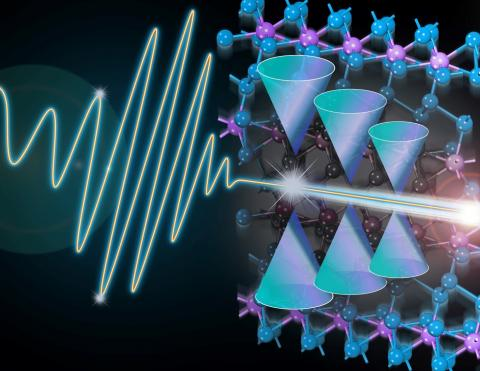Apr 21 2020
A light-induced switching mechanism has been identified in a Dirac semimetal by researchers from Ames Laboratory, Brookhaven National Laboratory, and the University of Alabama at Birmingham.
 Scientists who study topological materials face a challenge—how to establish and maintain control of these unique quantum behaviors in a way that makes applications like quantum computing possible. In this experiment, Jigang Wang and his colleagues demonstrated that control by using light to steer quantum states in a Dirac semimetal. Image Credit: Ames Laboratory.
Scientists who study topological materials face a challenge—how to establish and maintain control of these unique quantum behaviors in a way that makes applications like quantum computing possible. In this experiment, Jigang Wang and his colleagues demonstrated that control by using light to steer quantum states in a Dirac semimetal. Image Credit: Ames Laboratory.
The mechanism offers a new technique to manipulate the topological material, triggered by back-and-forth motion of electrons and atoms, which will allow quantum computation and a topological transistor using light waves.
Quite similar to the way existing photodiodes and transistors replaced vacuum tubes more than five decades ago, researchers are looking for an analogous leap forward in novel materials and design principles to realize quantum computing capabilities.
Current computation capacity is faced with huge difficulties with respect to power, speed consumption, and complexity. Considerable advances are required to surpass the physical limits reached as chips and electronics become hotter and faster. Specifically, at small scales, these problems have turned out to be the main barriers to enhancing performance.
Light wave topological engineering seeks to overcome all of these challenges by driving quantum periodic motion to guide electrons and atoms via new degrees of freedom, i.e., topology, and induce transitions without heating at unprecedented terahertz frequencies, defined as one trillion cycles per second, clock rates.
Jigang Wang, Senior Scientist, Ames Laboratory
Wang, who is also a professor of physics at Iowa State University, added, “This new coherent control principle is in stark contrast to any equilibrium tuning methods used so far, such as electric, magnetic and strain fields, which have much slower speeds and higher energy losses.”
Large-scale application of new computational principles, like quantum computing, necessitates the development of devices in which fragile quantum states are guarded against their noisy environments. One method is to develop topological quantum computation where qubits are based on “symmetry-protected” quasiparticles that are not affected by noise.
But researchers investigating these topological materials are faced with difficulty—how to find and control these exclusive quantum behaviors such that applications like quantum computing are rendered feasible.
As part of the experiment, Wang and his team exhibited how to achieve control through the use of light to drive quantum states in a Dirac semimetal—an exotic material that shows extreme sensitivity owing to its proximity to a wide range of topological phases.
We achieved this by applying a new light-quantum-control principle known as mode-selective Raman phonon coherent oscillations—driving periodic motions of atoms about the equilibrium position using short light pulses. These driven quantum fluctuations induce transitions between electronic states with different gaps and topological orders.
Ilias Perakis, Professor of Physics and Chair, University of Alabama at Birmingham
An analog to dynamic switching of this type is the periodically steered Kapitza’s pendulum, which can shift to an inverted yet stable position upon applying high-frequency vibration. The study demonstrates that this classical control principle—steering materials to a new stable condition that is not common—is strikingly applicable to a wider range of quantum phase transitions and topological phases.
Our work opens a new arena of light wave topological electronics and phase transitions controlled by quantum coherence. This will be useful in the development of future quantum computing strategies and electronics with high speed and low energy consumption.
Qiang Li, Group Leader, Advanced Energy Materials Group, Brookhaven National Laboratory
The spectroscopy and data analysis were carried out at Ames Laboratory. The development of the model and analysis were conducted, in part, at the University of Alabama at Birmingham. The development of the sample and magneto-transport measurements were carried out at Brookhaven National Laboratory.
The Center for the Advancement of Topological Semimetals, a DOE Energy Frontier Research Center at Ames Laboratory, supported the density functional calculations.
Further discussions on the study have been reported in the paper titled “Light-Driven Raman Coherence as a Non-Thermal Route to Ultrafast Topology Switching in a Dirac Semimetal,” which was published in Physical Review X and authored by C. Vaswani, L.-L. Wang, D.H. Mudiyanselage, Q. Li, P. M. Lozano, G. Gu, D. Cheng, B. Song, L. Luo, R. H. J. Kim, C. Huang, Z. Liu, M. Mootz, I.E. Perakis, Y. Yao, K. M. Ho, and J. Wang.